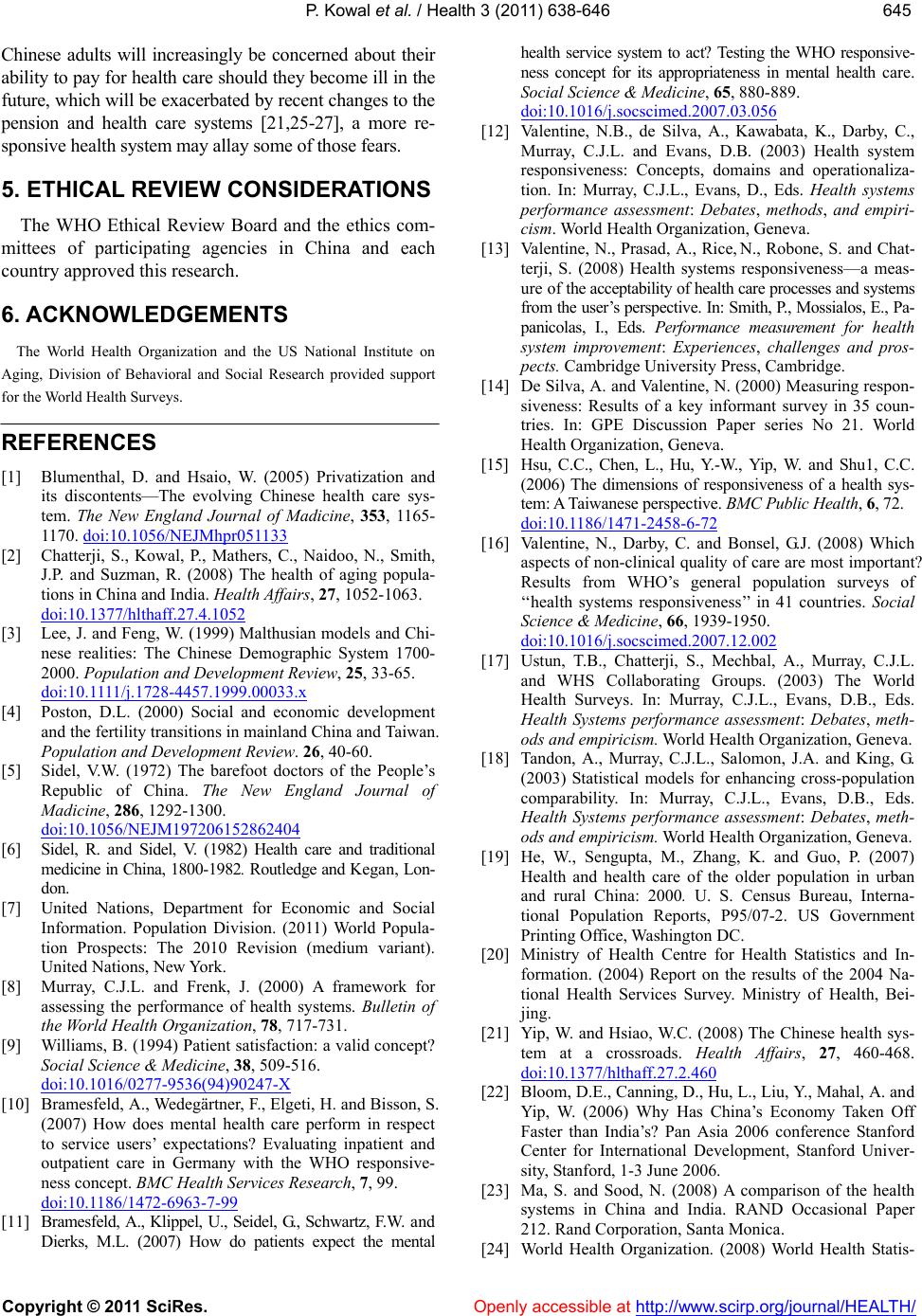
P. Kowal et al. / Health 3 (2011) 638-646
Copyright © 2011 SciRes. Openly accessible at http://www.scirp.org/journal/HEALTH/
645645
Chinese adults will increasingly be concerned about their
ability to pay for health care should they become ill in the
future, which will be exacerbated by recent changes to the
pension and health care systems [21,25-27], a more re-
sponsive health system may allay some of those fears.
5. ETHICAL REVIEW CONSIDE RATIONS
The WHO Ethical Review Board and the ethics com-
mittees of participating agencies in China and each
country approved this research.
6. ACKNOWLEDGEMENTS
The World Health Organization and the US National Institute on
Aging, Division of Behavioral and Social Research provided support
for the World Health Surveys.
REFERENCES
[1] Blumenthal, D. and Hsaio, W. (2005) Privatization and
its discontents—The evolving Chinese health care sys-
tem. The New England Journal of Madicine, 353, 1165-
1170. doi:10.1056/NEJMhpr051133
[2] Chatterji, S., Kowal, P., Mathers, C., Naidoo, N., Smith,
J.P. and Suzman, R. (2008) The health of aging popula-
tions in China and India. Health Af fairs, 27, 1052-1063.
doi:10.1377/hlthaff.27.4.1052
[3] Lee, J. and Feng, W. (1999) Malthusian models and Chi-
nese realities: The Chinese Demographic System 1700-
2000. Population and Development Review, 25, 33-65.
d oi : 10 .1111/ j.1 7 28 -4457.1999.00033.x
[4] Poston, D.L. (2000) Social and economic development
and the fertility transitions in mainland China and Taiwan.
Population and Development Review. 26, 40-60.
[5] Sidel, V.W. (1972) The barefoot doctors of the People’s
Republic of China. The New England Journal of
Madicine, 286, 1292-1300.
doi:10.1056/NEJM197206152862404
[6] Sidel, R. and Sidel, V. (1982) Health care and traditional
medicine in China, 1800-1982. Routledge and Ke ga n, Lon-
don.
[7] United Nations, Department for Economic and Social
Information. Population Division. (2011) World Popula-
tion Prospects: The 2010 Revision (medium variant).
United Nations, New York.
[8] Murray, C.J.L. and Frenk, J. (2000) A framework for
assessing the performance of health systems. Bulletin of
the World Health Organization, 78, 717-731.
[9] Williams, B. (1994) Patient satisfaction: a valid concept?
Social Science & Medicine, 38, 509-516.
doi:10.1016/0277-9536(94)90247-X
[10] Bramesfeld, A., Wedegärtner, F., Elgeti, H. and Bisson, S.
(2007) How does mental health care perform in respect
to service users’ expectations? Evaluating inpatient and
outpatient care in Germany with the WHO responsive-
ness concept. BMC Health Services Research, 7, 99.
doi:10.1186/1472-6963-7-99
[11] Bramesfeld, A., Klippel, U., Seidel, G., Schwartz, F.W. a nd
Dierks, M.L. (2007) How do patients expect the mental
health service system to act? Testing the WHO responsive-
ness concept for its appropriateness in mental health care.
Social Science & Medicine, 65, 880-889.
doi:10.1016/j.socscimed.2007.03.056
[12] Valentine, N.B., de Silva, A., Kawabata, K., Darby, C.,
Murray, C.J.L. and Evans, D.B. (2003) Health system
responsiveness: Concepts, domains and operationaliza-
tion. In: Murray, C.J.L., Evans, D., Eds. Health systems
performance assessment: Debates, methods, and empiri-
cism. World Health Organization, Geneva.
[13] Valentine, N., Prasad, A., Rice, N., Robone, S. and Chat-
terji, S. (2008) Health systems responsiveness—a meas-
ure of the acceptability of hea l th care processes and systems
from the user ’s perspective. In: Smith, P., Mossialos, E., Pa-
panicolas, I., Eds. Performance measurement for health
system improvement: Experiences, challenges and pros-
pects. Cambridge University Press, Cambridge.
[14] De Silva, A. and Valentine, N. (2000) Measuring respon-
siveness: Results of a key informant survey in 35 coun-
tries. In: GPE Discussion Paper series No 21. World
Health Organization, Geneva.
[15] Hsu, C.C., Chen, L., Hu, Y.-W., Yip, W. and Shu1, C.C.
(2006) The dimensions of responsiveness of a health sys-
tem: A T aiwanese perspective. BMC Public Health, 6, 72.
doi:10.1186/1471-2458-6-72
[16] Valentine, N., Darby, C. and Bonsel, G.J. (2008) Which
aspects of non-clinical quality of care are most important?
Results from WHO’s general population surveys of
‘‘health systems responsiveness’’ in 41 countries. Social
Science & Medicine, 66, 1939-1950.
doi:10.1016/j.socscimed.2007.12.002
[17] Ustun, T.B., Chatterji, S., Mechbal, A., Murray, C.J.L.
and WHS Collaborating Groups. (2003) The World
Health Surveys. In: Murray, C.J.L., Evans, D.B., Eds.
Health Systems performance assessment: Debates, meth-
ods and empiricism. World Health Organization, Geneva.
[18] Tandon, A., Murray, C.J.L., Salomon, J.A. and King, G.
(2003) Statistical models for enhancing cross-population
comparability. In: Murray, C.J.L., Evans, D.B., Eds.
Health Systems performance assessment: Debates, meth-
ods and empiricism. World Health Organization, Geneva.
[19] He, W., Sengupta, M., Zhang, K. and Guo, P. (2007)
Health and health care of the older population in urban
and rural China: 2000. U. S. Census Bureau, Interna-
tional Population Reports, P95/07-2. US Government
Printing Office, Washington DC.
[20] Ministry of Health Centre for Health Statistics and In-
formation. (2004) Report on the results of the 2004 Na-
tional Health Services Survey. Ministry of Health, Bei-
jing.
[21] Yi p, W. and Hsiao, W.C. (2008) The Chinese health sys-
tem at a crossroads. Health Affairs, 27, 460-468.
doi:10.1377/hlthaff.27.2.460
[22] Bloom, D.E., Canning, D., Hu, L., Liu, Y., Mahal, A. and
Yip, W. (2006) Why Has China’s Economy Taken Off
Faster than India’s? Pan Asia 2006 conference Stanford
Center for International Development, Stanford Univer-
sity, Stanford, 1-3 June 2006.
[23] Ma, S. and Sood, N. (2008) A comparison of the health
systems in China and India. RAND Occasional Paper
212. Rand Corporation, Santa Monica.
[24] World Health Organization. (2008) World Health Statis-